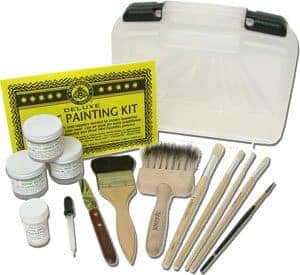Firing Paint Quickly in a Kiln

Zebra Glass Painting Designs
I know that I have fired painted glass ramping up from room temp to 1250F/676C degrees in 35 min. I would then turn off the kiln and let it cool down naturally and start venting at 500F/260C degrees. Using this process I could be able to start another layer of painting in about 3hours or less. I realize there is risk of shock but when I am in a time bind sometimes it is a necessity, especially when I need to do 2-3 firings in a work day.
I recently bought a new kiln that has several pre-programmed settings, but there is not one for painting. The fastest ramp time is 300 degrees/hr which seems way too slow. I can create a custom program, so my true question is: What is the fastest, dependable firing schedule that I can use for basic Reusche line work and matting? Mary
Milly’s reply:
You can fire a piece of 3mm glass 40cms X 60cms to 1200F/650C in 15mins in a gas glass kiln, but I wouldn’t go that fast in an electric one. I think you could push it up to 900F/500C degrees an hour without harm, but it does depend on how big your glass pieces are.
If I’m right in assuming the 300 degrees in the pre-programmes are in Fahrenheit (149C), then that is way too low for a simple stained glass paint project. If you’ve got time (!) test out some different sized bits of glass ramping up at 900F/500C degrees an hour just to make sure. If not, just go for it!
Problems with Glass Paint and Patina
I have just begun traditional stained glass painting. I finished and kiln fired several pieces with Reusche paints, copper foiled them together, soldered, and lastly put patina on the lead seams. The patina discolored the painted glass and made the surface gray and noticeable and obvious. What went wrong and how can I avoid this?
Thank-you
Milly’s reply:
This is a brilliant question Joan, thanks. Why? Because it gives me the chance to warn everyone against using black patina with glass paint – the patina contains nitrate acid and will remove the fired paint!
I don’t know why there aren’t any warnings about this on the black patina bottles. Perhaps it’s because the copper foil technique is more commonly used for stained glass work that hasn’t been painted, and so a warning is not deemed necessary? There should be one on there.
I think you were lucky that your painted work didn’t disappear all together, instead of just going gray – Reusche paints are the highest quality so maybe that’s why. I’ve heard of other glass artists losing painted work all together with black patina (Novacan in particular).
You can neutralise the effects of it with baking soda, but it might be too late to rescue your ‘gray’ paint Joan – you really have to do it immediately.
As for the patinas – the copper one doesn’t have this effect on paint, so in future you could try using that – or learn leading and blacken it with graphite!
Sorry I can’t offer a fix, but good luck with your future projects.
This painting starter kit is available on Amazon
This painting starter kit is available on Amazon Peter Mcgrain Deluxe Paint Starter Kit


